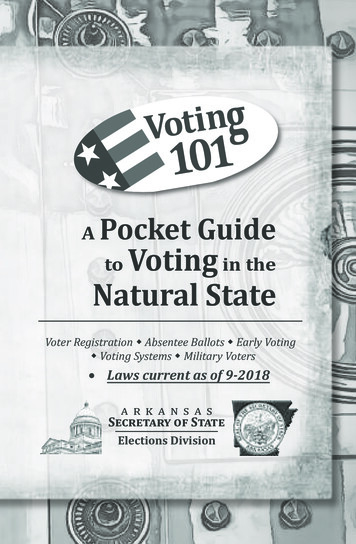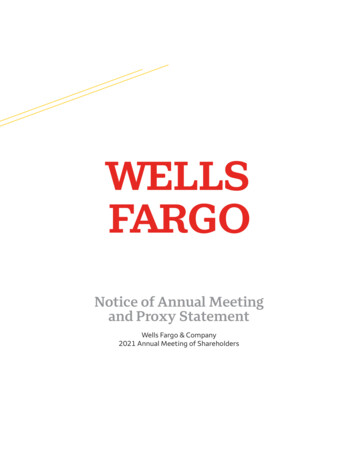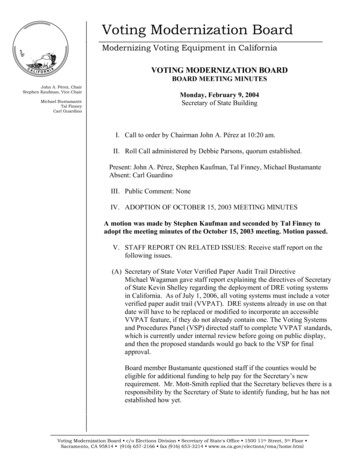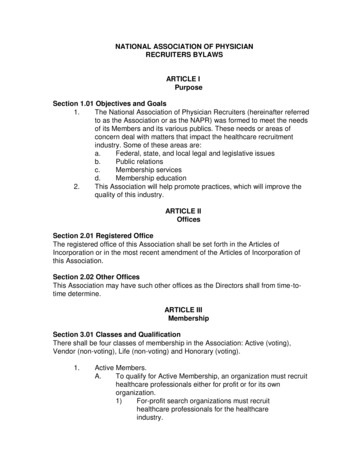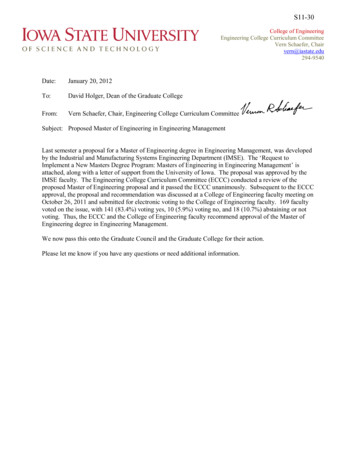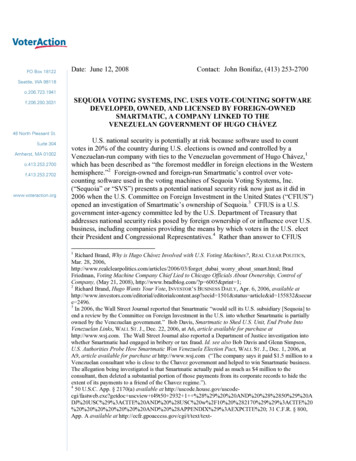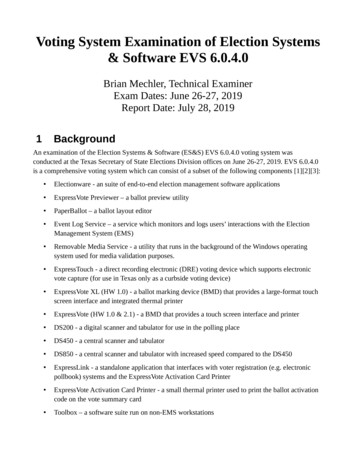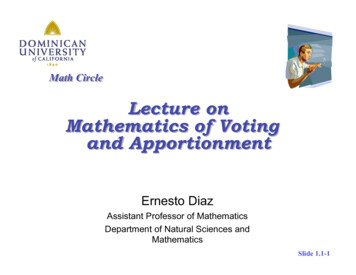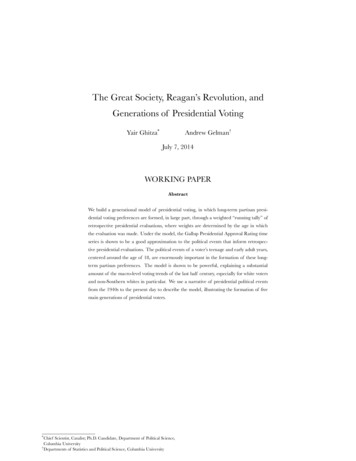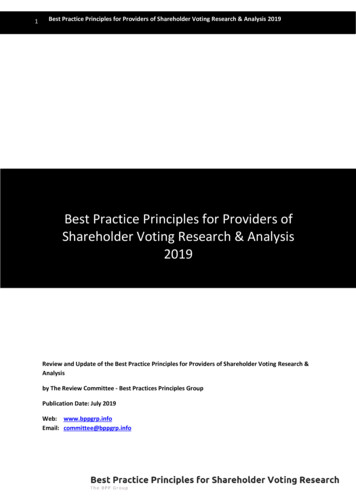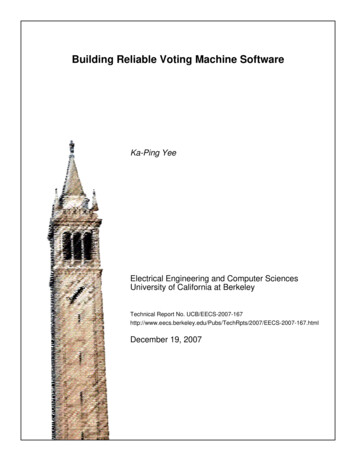
Transcription
Building Reliable Voting Machine SoftwareKa-Ping YeeElectrical Engineering and Computer SciencesUniversity of California at BerkeleyTechnical Report No. /TechRpts/2007/EECS-2007-167.htmlDecember 19, 2007
Copyright 2007, by the author(s).All rights reserved.Permission to make digital or hard copies of all or part of this work forpersonal or classroom use is granted without fee provided that copies arenot made or distributed for profit or commercial advantage and that copiesbear this notice and the full citation on the first page. To copy otherwise, torepublish, to post on servers or to redistribute to lists, requires prior specificpermission.AcknowledgementI am grateful to many people who helped make this dissertation possible.My advisors: David Wagner, Marti Hearst.My committee members: Henry Brady, Joe Hellerstein.Advice: Steve Bellovin, Candy Lopez, Scott Luebking, Noel Runyan,Joseph Hall.Security review: Matt Bishop, Ian Goldberg, Tadayoshi Kohno, Mark Miller,Dan Sandler, Dan Wallach.Funding: National Science Foundation, through ACCURATE.Thanks also to Scott Kim, La Shana Porlaris, Lisa Friedman, and myparents.
Building Reliable Voting Machine SoftwareKa-Ping YeeB. A. Sc. (University of Waterloo) 1998A dissertation submitted to the Graduate Divisionof the University of California, Berkeleyin partial fulfillment of the requirements for the degree ofDoctor of PhilosophyinComputer ScienceCommittee in charge:Professor David Wagner, Co-chairProfessor Marti Hearst, Co-chairProfessor Henry BradyProfessor Joseph HellersteinFall 2007
The dissertation of Ka-Ping Yee is approved.Professor David Wagner (Co-chair)DateProfessor Marti Hearst (Co-chair)DateProfessor Henry BradyDateProfessor Joseph HellersteinDateUniversity of California, BerkeleyFall 2007
Building Reliable Voting Machine SoftwareCopyright 2007Ka-Ping YeePermission is granted to copy, distribute, and/or modify this document under the termsof the GNU Free Documentation License, version 1.2 or any later version published by theFree Software Foundation, with no Invariant Sections, no Front-Cover Texts, and noBack-Cover Texts. A copy of the license is included in the appendix entitled GNU FreeDocumentation License.
AbstractBuilding Reliable Voting Machine SoftwareKa-Ping YeeDoctor of Philosophy in Computer ScienceUniversity of California, BerkeleyProfessor David Wagner, Co-chairProfessor Marti Hearst, Co-chairI examine the question of how to design election-related software, with particularattention to the threat of insider attacks, and propose the goal of simplifying the softwarein electronic voting machines. I apply a technique called prerendering to reduce thesecurity-critical, voting-specific software by a factor of 10 to 100 while supporting similaror better usability and accessibility, compared to today’s voting machines. Smaller andsimpler software generally contributes to easier verification and higher confidence.I demonstrate and validate the prerendering approach by presenting Pvote, avote-entry program that allows a high degree of freedom in the design of the userinterface and supports synchronized audio and video, touchscreen input, and inputdevices for people with disabilities. Despite all its capabilities, Pvote is just 460 lines ofPython code; thus, it directly addresses the conflict between flexibility and reliability thatunderlies much of the current controversy over electronic voting. A security review ofPvote found no bugs in the Pvote code and yielded lessons on the practice of adversarialcode review. The analysis and design methods I used, including the prerenderingtechnique, are also applicable to other high-assurance software.Professor David WagnerProfessor Marti Hearst1
This dissertation is dedicated to those who work to runelections everywhere in the world: registrars, officers,pollworkers, clerks, judges, scrutineers, observers, andeveryone else involved in the process. You carry out themechanisms that make democracy work; this research isdevoted to helping you make democracy work better.i
PrefaceThe democracy upon which our modern society is builtultimately depends on a system that collects and counts votes.For many voters in the United States and other countries, nearlyevery part of that system relies on computer software in someway. If you had to design that software, how would you do it?This dissertation offers an exploration of that question anda proposed answer: create the simplest possible voting machinesoftware. I use a technique called prerendering to reduce thecritical voting-specific software by a factor of 10 to 100 whilesupporting similar or better accessibility and usability,compared to today’s machines. Central to this dissertation isthe story of Pvote, the program I developed to realize this goal.The first reason to simplify software is the threat of aninsider attack. The challenge is to prevent not just inadvertentflaws, but flaws intentionally crafted by programmers whostand to gain from subverting their own software. The only wayto meet this challenge is to require simpler software.The second reason is that much of the controversy overelectronic voting stems from a conflict between flexibility andreliability. Computers offer the promise of broader and moreeffective access to voting, but computer programs are morecomplicated and fragile than hand-counted paper ballots.Simplifying the voting machine software mitigates this dilemma.The problem of electronic voting is illustrative of thechallenges of building reliable software in general. In particular,I report on insights from the Pvote work about managing thecomplexity of high-assurance software and about reviewingsoftware for correctness without assuming trust in its author.Both are relevant to the prevention of insider attacks, which area thorny and long-standing problem in software security.ii
This dissertation is intended for several audiences: Election staff, policymakers, and activists: If you runelections or influence how elections are conducted, I hopeto make you aware of the perils of complexity in software(Chapters 1 and 9), and to calibrate your tolerance forcomplexity in election software by demonstrating how muchit can be simplified. I also hope to contribute to yourunderstanding of the tradeoffs among various choices ofvoting equipment and verification methods (Chapter 3). Engineers: If you build software, you may be able to achievegreater confidence in it using the analysis, design, andreview strategies presented here (Chapters 2, 3, and 8). Ifyou develop voting machines, you can apply theprerendering strategy to create more reliable software(Chapter 4), use ideas from Pvote’s design andimplementation (Chapters 5, 6, and 7), or use the Pvote codeas a basis for your own software (Appendices A and B). Researchers: If you investigate software reliability orsecurity, you may be interested in assurance trees (Chapter2), a way of structuring assurance claims during softwaredesign, prerendering (Chapter 4) as a strategy for reducingthe trusted code base of a system, or derivation maps(Chapter 9) for understanding sources of vulnerability toinsiders and the effects of shifting complexity amongcomponents. The Pvote review experience (Chapter 8 andAppendix E) motivates research challenges in the design ofprogramming languages, development environments, andreviewing tools to support adversarial code review. Designers: If you practice visual design or interactiondesign, you may be interested to learn how prerendering(Chapter 4), the main software approach presented here, canoffer you unprecedented freedom in designing electronicballots and new opportunities for advancing democracythrough the power of design.Prefaceiii
ContributionsThis is a quick guide to the main contributions of this work andwhere to find them.1. A set of correctness properties for voting software derived asan assurance tree (page 24).2. An assurance chart comparing types of voting systemsaccording to the verification mechanisms available to votersat each step of the voting process (page 56).3. User interface prerendering, a technique for reducing thecomplexity of critical software components (page 57).4. Pvote’s ballot definition file format, a platform-independentformat for describing the ballot and the voting user interfacein a prerendered user interface voting system (page 121).5. The software design of Pvote, a vote-entry program withsupport for a wide range of ballot designs and voters withdisabilities (page 127).6. A set of desirable properties of programming languages tosupport adversarial code review (page 149).7. Lessons learned from the Pvote security review, the firstopen adversarial code review of voting software designedfor minimal complexity and high assurance (page 153).8. Derivation mapping, a method of diagramming theprovenance of a security-critical artifact to identify sourcesof vulnerability to insider attacks (page 161).9. A security argument for the use of high-level programminglanguages in high-assurance software (page 173).10. Proof by construction (the implementation of Pvote) that afully featured user interface for voting can be implementedin 460 lines of Python (page 217).11. A security analysis and a set of assurance arguments forPvote, which are given in a separate document [92].iv
AcknowledgementsI have been extremely lucky to have David Wagner and MartiHearst as my advisors. They supervised and supported thiswork, and provided me with guidance and insight during mycareer as a graduate student. They removed obstacles andsought out opportunities for me. Their responsiveness anddetailed feedback have been fantastic. I also thank Henry Bradyand Joe Hellerstein, who served on my committee and went outof their way to review this dissertation on a short time frame.Steve Bellovin suggested the idea of prerendering, whichsparked this work. Candy Lopez of the Contra Costa CountyElections Department patiently showed me how real electionsare run. Scott Luebking and Noel Runyan helped me understandthe accessibility issues surrounding voting. Matt Bishop, IanGoldberg, Tadayoshi Kohno, Mark Miller, Dan Sandler, and DanWallach generously volunteered many, many hours of their timeto serve as expert reviewers in the Pvote security review. JosephHall has been a wonderful resource on election policy.Debra Bowen and David Wagner created and gave me therare opportunity to review the source code of a widely usedcommercial voting system in the California Top-to-BottomReview. It was a privilege to work with my collaborators on thatproject: Matt Blaze, Arel Cordero, Sophie Engle, Chris Karlof,Naveen Sastry, Micah Sherr, and Till Stegers.Public attention to electronic voting did not appearovernight; it is the result of a long history of hard work bycivic-minded heroes such as David Dill (founder of the VerifiedVoting Foundation), Avi Rubin (director of ACCURATE), andmany others. Their efforts are a big part of what has maderesearch like mine possible. This work was funded by theNational Science Foundation, through ACCURATE.v
Mark Miller, Jonathan Shapiro, and Marc Stiegler sparked myinterest in computer security and have deeply shaped myunderstanding of it through many years of fruitful collaborationand shared wisdom. I am exceptionally fortunate to have metand worked with them.Scott Kim’s dissertation inspired the page design of thisdissertation. La Shana Porlaris of the EECS Department savedme from crisis time and again; her help and calm advice wereinvaluable.I am especially grateful to Lisa Friedman for her supportduring the writing of this dissertation, and to my parents, for alifetime of devotion to me and my education.vi
svContentsxVoting1What makes the voting problem so hard?2How does an election work?6Why use computers for elections?9How did electronic voting become controversial?11Why does software correctness matter?14Correctness16What constitutes a democratic election?17What does it mean for a voting system to be correct?19How does correctness relate to safety?20What is the tree of assurance goals for an election?24What does it mean for a voting system to be secure?30Verification33How do we gain confidence in election results?34How can we verify the computerized parts of an election?36What kind of election data can be published?39What makes software hard to verify?41In what ways are today’s voting systems verifiable?44What is the minimum software that needs to be verified?48What other alternatives for verification are possible?52vii
4567Prerendering57How can we make vote-entry software easier to verify?58What is prerendering?59Why put the entire user interface in the ballot definition?60How would a voting computer use a prerendered ballot?62What is gained by publishing the ballot definition?63What are the advantages of prerendering?65How can prerendering be applied to other software?66How are votes recorded anonymously?67Ptouch: the touchscreen prototype69Overview70Ballot definition format71Software Accessibility96Why was a second prototype needed?97What is Pvote’s approach to accessibility?98How are alternative input devices handled?99How does blindness affect interface navigation?100How do blind users stay oriented within an interface?101How do blind users keep track of what is selected?102How do blind users get feedback on their actions?103How are vision-impaired users accommodated?104Pvote: the multimodal prototype105Overview106Goals107Design principles110Differences between Pvote and Ptouch114Ballot definition format121Software design127Implementation132Evaluation133viii
8Security review136How was Pvote’s security evaluated?137What were Pvote’s security claims?139How was Pthin defined?143What flaws did the reviewers find?145What improvements did the reviewers suggest?146Did the reviewers find the inserted bugs?148What ideas did reviewers have on programming languages? 149910AWhat ideas did reviewers have on conducting reviews?151What lessons were learned from the review?153Complexity156Does prerendering actually eliminate complexity?157What is achieved by shifting complexity?158Why do software reviews assume trust in compilers?160How far back can the derivation of a program be traced?161What affects the tolerance of complexity in a component?164How does Pvote reallocate complexity?167What is gained by using interpreted languages?173Related work174Do any other voting systems use prerendering?175What other voting proposals reduce reliance on software?176What are “frog” voting systems?177Do frogs solve the electronic voting problem?178What is “software independence” (SI)?179Does SI make software reliability irrelevant?181What is end-to-end (E2E) verification?186Does E2E verification make software reliability irrelevant?187What are other approaches to high-assurance software?188Conclusion191Bibliography193Ptouch source code204main.py205ix
15Pvote source or.py228Audio.py233Video.py235Printer.py236CSample Pvote ballot definition237DSample Pvote ballot designs267EPvote security review findings272Correctness273Consensus recommendations278Inconclusive recommendations282Observations284Open issues288Bug insertion296Review process300Post-review survey304GNU Free Documentation License306Bx
1VotingWhat makes the voting problem so hard?2How does an election work?6Why use computers for elections?9How did electronic voting become controversial?11Why does software correctness matter?141
What makes the voting problem so hard?When I say the “voting problem,” I’m referring specifically to thesystem that collects and counts votes. There are many otherparts of the election process that I’m not going to address inthis dissertation, such as voter registration, electoral systems,and election campaigning. The collection and counting of voteshas been particularly controversial in the United States due toproblems with electronic voting in recent elections.One of the great things about doing election-relatedresearch is that just about everyone immediately understandswhy it’s important. In my experience, whenever elections arethe topic of conversation, people have a lot to say about theiropinions on the matter. It’s encouraging to see that so manypeople care deeply about democracy.In conversations about the voting problem, there seem to befour ideas in particular that come up all the time. It’s notunusual to think that running a fair election ought to be astraightforward task—after all, in some sense, it’s just counting.To give you a taste of why the voting problem is not as easy as itmight seem, let’s begin by examining these four suggestions.Banking machines work fine, so voting machines should beno problem. On the surface, banking machines and votingmachines seem similar: users walk up and make selections on atouchscreen to carry out a transaction. One of the largestvendors, Diebold Inc., even produces both kinds of machines.But the incentives and risks are very different.Banking machines have money inside—the bank’s money. Ifmoney goes missing, you can bet the bank will find out rightaway and be strongly motivated to fix the problem. If the bankmachine incorrectly gives out too much cash, the bank losesmoney; if it gives out too little, the bank will be dealing withirate customers. Everything about the bank transaction isrecorded, from the entries in your bank statement to the videorecorded by the camera in most bank machines. That’s becauseVoting2
the bank has a strong incentive to audit that money and trackwhere it goes. If the machine makes mistakes, the bank loses—either they expend time and money correcting your problem, oryou will probably leave and take your business to another bank.With voting machines, it’s another story altogether. Votingmachines aren’t supposed to record video or keep any recordthat associates you with your votes, because your ballot issupposed to be secret. You don’t receive any tangibleconfirmation that your vote was counted, so you can’t find outif there’s a problem. Anybody can stand to gain by causingvotes to be miscounted—a voter, pollworker, electionadministrator, or voting machine programmer—and theconsequences are much harder to reverse. Correcting an errorin your bank balance is straightforward, but the only way to fixan improperly counted election is to do an expensive manualrecount or run the whole election again. And if you’re unhappywith the way your vote was handled, you can’t easily choose tovote on a competitor’s machine.Give each voter a printed receipt, just like we do for anyother transaction. The surface comparison between voting anda financial transaction also leads many people to suggest thatreceipts are the answer. But the purpose of a receipt is quitedifferent from what is needed to ensure an accurate election.When you buy something, the receipt confirms that youpaid for it. If there turns out to be a problem with the product,you can use the receipt to get your money back or to get thedefective product exchanged.When talking about a receipt from a voting machine, whatmost people have in mind is a printed record of the choices youmade, just like a receipt from a cash register. If you took homesuch a receipt, what would you do with it? There’s nothing torefund, and you can’t use a receipt to get an exchange on adefective politician. The receipt could record the choices youmade, but the receipt alone doesn’t assure that those choiceswere counted in the final result. In fact, if the receiptconstitutes proof of which choices you made, it can be sold—Voting3
defeating the whole point of the secret ballot, which is to avoidthe corruption that vote-buying campaigns can cause.A truly useful voting “receipt” would do exactly theopposite: it would not reveal which choices you made but wouldlet you confirm that your choices were counted. Although thesetwo requirements sound paradoxical, researchers have inventeda variety of schemes that achieve them through the clever useof cryptography. However, a key weakness of the schemesproposed so far is that they rely on advanced mathematics, witha counting process that would be a mystery to all but a tinyminority of voters. This would run counter to the democraticprinciple of transparent elections. Researchers are continuingto search for simpler verification schemes that can beunderstood by an acceptably large fraction of the public.If we can trust computers to fly airplanes, we can trustcomputers to run elections. The comparison between airplanesand elections misses at least three key differences.First, the visibility of failure is different. An airplane cannotsecretly fail to fly. When an airplane crashes, it makesheadlines; everybody knows. A forensic investigation takesplace, and if the crash is due to a manufacturing defect, theairplane manufacturer may be sued for millions of dollars. Butan election system can produce incorrect results without anyobvious signs of failure. Therefore, we require something morefrom election system software than what we require fromairplane software. A successful election system must not onlywork correctly; it must also allow the public to verify that itworked correctly.Second, the target audience is different. Commercialairplanes are designed to be flown by pilots with experttraining, but voting machines have to be set up by pollworkersand operated by the general public. Our trust in airplanes is acombination of trust in the equipment and trust in the pilotswho operate it. Whereas pilots have to log hundreds of hours offlight time to get a license, pollworkers are often hired on atemporary basis with only an afternoon or a day of training.Voting4
Third, security violations affect the perpetrators differently.Pilots and flight attendants are strongly motivated to upholdsecurity procedures because their own lives could be at risk. Arogue voter or pollworker, on the other hand, would have moreto gain and less to lose by surreptitiously changing the outcomeof an election.Count the ballots by hand—it works for the Canadians.Ballots are considerably longer and more complicated in theUnited States than in many other countries. Whereas there isjust one contest in a Canadian federal election (each voterselects a Member of Parliament), ballots in the United States cancontain dozens of contests. For example, a typical ballot1 for theNovember 2004 general election in Orange County, Californiacontained 7 offices and 16 referenda, for a total of 23 conteststhat would have to be tallied by hand. Ballots in Chicago, Illinoisthat year2 were even longer: ten pages of selections, consistingof 15 elected offices, confirmations of 74 sitting judges, andone referendum—a total of 90 contests. When you appreciatethe scale of the task, it becomes easier to understand why manypeople are motivated to automate the process with computers.Hand-counting paper ballots is by no means impossible, but itwould be considerably more expensive and time-consuming inthe United States than in other countries with simpler ballots. In summary, voting is especially challenging because: All involved parties can gain by corrupting an election. Results can be incorrect without an obvious failure. Democracy demands verifiability, not just correctness. Voter privacy and election transparency are in conflict. Elections must be accessible and usable by the public. Ballots in the United States are long and complex.1The example here is Orange County’s ballot type SB019 from November 2004, available in NIST’s collectionof sample ballots at http://vote.nist.gov/ballots.htm.2This refers to the “Code 9” ballot style in Cook County, Illinois (also available in NIST’s collection), used inWard 19, Precincts 28, 43(R), 48, 50(R), and 66, as well as precincts in Wards 21 and 34.Voting5
How does an election work?Running an election is a tremendous organizational task. In theend, it does come down to counting, but it’s what’s beingcounted that makes it such a challenge. Election administratorsare, in effect, trying to take a fair and accurate measurement ofthe preferences of the entire population—a controlledexperiment on a grand scale. As any psychologist will tell you,performing experimental measurements on human subjects isfraught with logistic pitfalls and sources of error. But electionsare worse: virtually everybody has an incentive to actively biasthe measurement toward their own preferred outcome. Thus,elections involve a security element as well, unlike mostscientific measurements.As if that weren’t enough, a typical election in the UnitedStates is not just one opinion poll but many different pollsconducted on the same day—for federal, state, and local electedoffices, as well as state and local referenda—and each poll hasto be localized to a specific region. Each contest appears onsome ballots but not others, resulting in different combinationsof contests on different ballots. Each combination is called aballot style. Because there are so many kinds of districts (suchas congressional districts, state assembly districts,municipalities, hospital districts, and school districts), anddistrict boundaries of each kind often run through districts ofother kinds, there can be over a hundred different ballot stylesin a single county. There can also be multiple ballot styles atone polling place, if it serves voters on both sides of a districtboundary, or if there are different ballots for voters of differentpolitical parties.Process. Here is a simplified breakdown of the election process,setting aside voter registration and considering only thecollection and counting of votes. The events before, during, andafter actual voting make up the three stages of the process:preparation, polling, and counting.Voting6
Preparation. Before any votes can be cast, election officialsmust prepare the ballots. Election officials map out all thedifferent kinds of political districts, assemble the conteststhat are relevant to each political district, compose thecontests into ballot styles, and determine which ballot stylesgo to which polling places. Polling. At polling places, pollworkers sign in each voter andmake sure that each voter gets the correct style of ballot.Each voter makes their selections privately and casts aballot. Voters may also have the option of voting by mail orparticipating in “early voting” by showing up in person at aspecial polling place before election day. Counting. The records of cast votes are counted, either atthe polling places or at a central election office. If countinginitially occurs at polling places, the counts are thentransmitted to the central office for tallying. The votes foreach contest are extracted from all the ballots on which thatcontest appears, and tallied to produce a result.Equipment. The preceding description is intentionallyambiguous about whether paper or electronic voting is used,because the same three stages take place regardless of the typeof equipment.If paper ballots are used, a layout is prepared for each ballotstyle, usually designed on a computer. Election administratorsestimate how many ballots of each style will be needed so thatan adequate number can be printed for distribution to pollingplaces. After being marked, paper ballots can be counted byhand or scanned on machines (called optical scanningmachines). The scanning can take place at the polls (precinctcount optical scanning), where each voter feeds their ballotthrough a scanning machine into a ballot box, or it can takeplace at a central office, where all the paper ballots are gatheredand scanned in high-speed machines after polls close (centralcount optical scanning).An alternative to paper ballots is to make selections on anelectronic voting machine that directly records the selections inVoting7
computer memory. These machines are called direct recordingelectronic (DRE) machines. In this case, preparing ballotsconsists of producing ballot definition files on electronic media(such as memory cards or cartridges) to be placed in votingmachines. The ballot definition determines what will bedisplayed to the voter. (Machines for scanning paper ballotsalso require ballot definitions that specify how the marks on thepaper should be counted.) Some DRE machines also print avoter-verified paper audit trail (VVPAT)—a paper record of thevoter’s selections that is shown to the voter for confirmation,but kept sealed inside the machine to enable later recounts. To sum up, there are three broad categories of elections interms of how machines are used:1. Vote on paper; count by hand.2. Vote on paper; count by machine.3. Vote on machine; count by machine.(3a. The voting machine may also produce a paper record.)Voting8
Why use computers for elections?As the preceding description makes clear, all three stages of theelection process involve complex and detail-oriented work.Preparation involves managing information about all thedifferent contests, candidates, and ballot styles. Polling involvesdistributing this information and collecting results from all thepolling places. Counting involves consolidating all the votes foreach candidate in each contest across all the ballots and ballotstyles. With so many contests on the ballot, computers canmake this process much easier.It’s not surprising that election administrators have lookedto computers for help with elections. Computers are used togreat benefit in automating a broad range of complex andrepetitive tasks and for recordkeeping functions throughout allkinds of government agencies. Running an election involvesorganizing and processing a lot of information, such as ballotdescriptions and vote tallies, and databases are effective toolsfor managing
Building Reliable Voting Machine Software Ka-Ping Yee Doctor of Philosophy in Computer Science University of California, Berkeley Professor David Wagner, Co-chair Professor Marti Hearst, Co-chair . A set of correctness properties for voting software derived as an assurance tree (page 24). 2.
